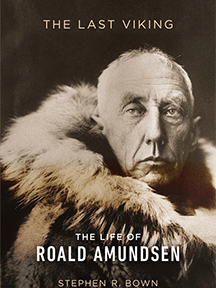By Colin Rafferty
In literature, at least, we enjoy things going wrong. If there is no conflict, there is no story, and nothing at stake for either the protagonist or the reader. Perhaps this is why polar explorer Roald Amundsen (1872-1928) is less well-known than his counterparts Ernest Shackleton or Robert Scott; his mania for careful planning of expeditions, his embrace of both new technologies and native methodologies, and his steely determination resulted in almost every expedition he led succeeding without loss of life or danger to him or his crew. Yet Amundsen, in a twenty-year span, managed to capture the four largest prizes in polar exploration, reaching both the North and South Poles first as well as commanding the first successful navigations of the Northeast and Northwest Passages.
Stephen R. Bown’s biography of the Norwegian hero sidesteps the lack of trauma in Amundsen’s voyage by focusing on the man himself, and tracing how the young Amundsen’s experience onboard the Belgica under its captain Adrian de Gerlache resulted in the adult explorer’s knowledge of how to survive the brutal winters in the extreme corners of the globe.
One of Bown’s strengths in writing this biography is his ability to write about Amundsen’s expeditions—often multi-year affairs during which the crew was completely isolated—in a way that engages readers accustomed to satellite phones and real-time updates. Although each expedition had to deal with boredom while frozen into the ice or building temporary complexes in which they weathered Arctic winters, Bown’s clear prose never gets bogged down by the vast emptiness of its settings or by Amundsen’s regular successes in his expeditions. And when things do go wrong, such as when Amundsen attempts to fly a plane over the North Pole, Bown writes a tense narrative in which men struggle against themselves and nature to survive, in part thanks to their leader’s embrace of native traditions (such as the wearing of sealskin clothes) and new technologies like radio and air flight.
Bown’s book, structured around the four cardinal points of the compass, follows Amundsen’s four major expeditions as they happen. He recounts the months of preparation for each voyage, revealing Amundsen’s meticulous planning, as well as the ways in which that planning paid off when the crews finally reached the ice. He dissects the infamous “Race to the Pole,” asserting that neither Amundsen nor the doomed Scott regarded themselves as competing against the other, while also explaining how British resentment over being beaten to the South Pole resulted in Amundsen’s diminished stature in that country. Bown also considers Amundsen’s relationship with the press, which was necessary for promoting and fundraising expeditions, but which also aggravated the explorer to no end, especially when it scooped his accomplishments.
To his credit, Bown does not avoid the darker corners of Amundsen’s life, delving into his financial arguments with his brother as well as his affair with a married woman. In addition, Bown looks at the problematic relationship Amundsen had with the Fascist Italian government, who helped sponsor his last major expedition, the crossing of the North Pole in the airship Norge. Bown avoids condemnation of Amundsen for these faults, seeing them instead as the necessary compromises of a man who could not remain in one place for too long.
Amundsen disappeared in 1928 while flying off to rescue a crew of men stranded in the Arctic, and while his accomplishments have not diminished since then, he has been overshadowed by the dramatic narratives of those who could not achieve the prizes he won. The Last Viking should restore this remarkable man’s place in the canon of explorers, while winning itself a prized place on the shelves of adventure enthusiasts.
Colin Rafferty (ΦBK,Kansas State University, 1998) teaches nonfiction writing at the University of Mary Washington in Fredericksburg, Virginia. Mary Washington is home to the Kappa of Virginia chapter of Phi Beta Kappa.




